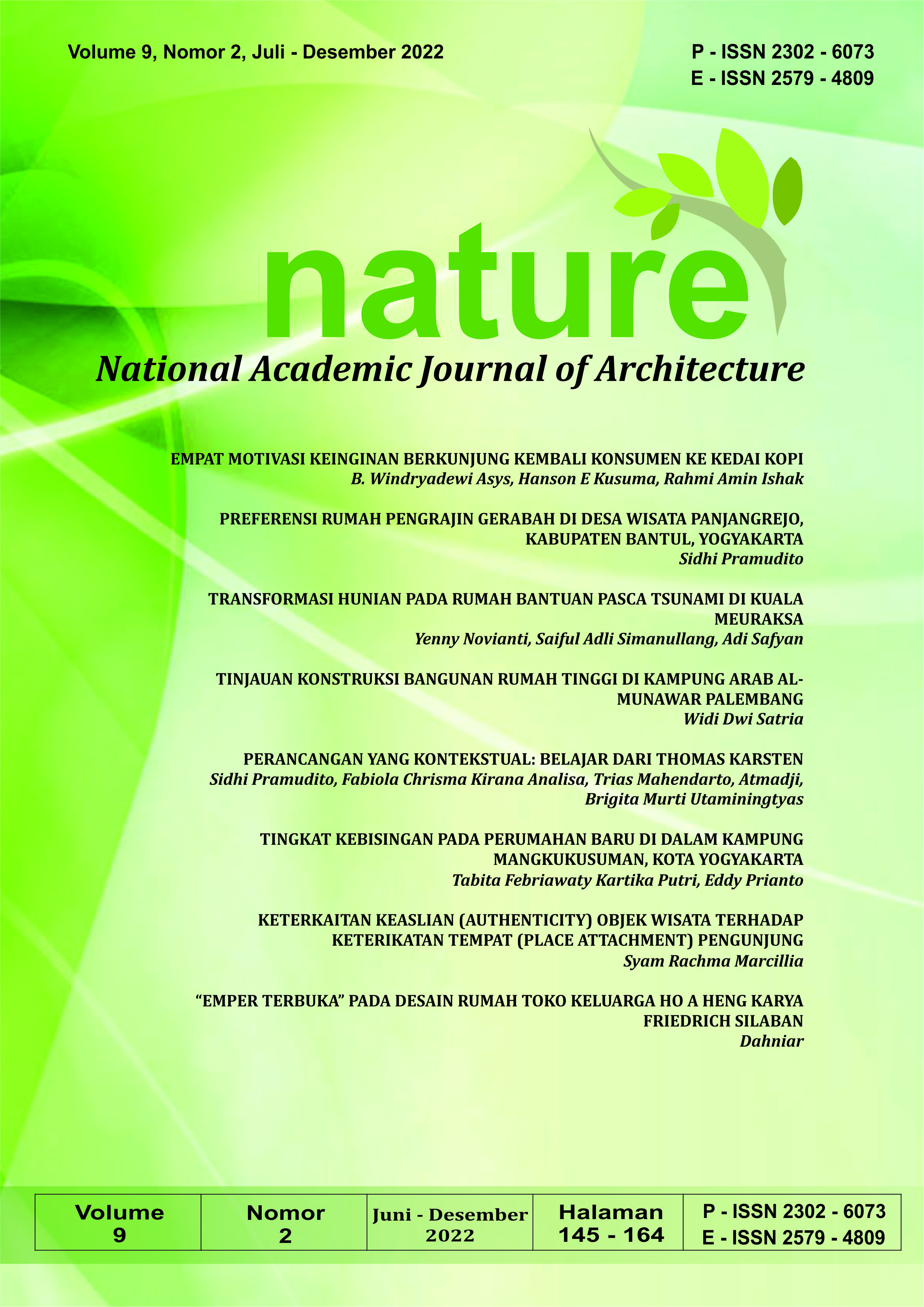KETERKAITAN KEASLIAN (AUTHENTICITY) OBJEK WISATA TERHADAP KETERIKATAN TEMPAT (PLACE ATTACHMENT) PENGUNJUNG
Abstract
Abstrak_ Nilai keaslian suatu objek wisata menjadi faktor penting yang mempengaruhi tingkat kunjungan wisatawan untuk meningkatkan keterikatan (attachment) wisatawan terhadap tempat wisata. Hal ini membuat wisatawan memiliki hubungan khusus yang menjadikan mereka ingin kembali mendatangi objek wisata terkait. Penelitian dilakukan untuk menguji hubungan antara nilai keaslian (authenticity) dengan keterikatan tempat (place attachment) pengunjung pada destinasi wisata di Yogyakarta. Responden penelitian terdiri dari 65 wisatawan yang pernah berkunjung ke Keraton Kesultanan Yogyakarta dan Monumen Jogja Kembali. Pengambilan data dilakukan dengan kuesioner yang terdiri dari 5 (lima) bagian, yaitu data responden, informasi dasar tentang objek wisata, nilai keaslian (authenticity) objek wisata, nilai keterikatan tempat (place attachment), dan evaluasi kepuasan wisatawan. Hasil penelitian menunjukkan bahwa Keraton memiliki jumlah pengunjung yang lebih tinggi dibandingkan dengan Monjali. Alasan tingginya jumlah kunjungan Keraton sebagai objek wisata dengan daya tarik budaya adalah karena memiliki nilai authenticity yang lebih tinggi dan mempengaruhi place attachment terhadap pengunjung. Nilai ini relevan dengan konteks sejarah atau warisan di Yogyakarta sehingga mampu memberikan keterikatan secara fungsional dan emosional.
Kata Kunci: Keaslian; Keterikatan Tempat; Daya Tarik Wisata; Objek Wisata.
Abstract_The authenticity value of a tourist attraction is an essential factor that influences the number of visits to increase tourists’ attachment to tourist attractions. This makes tourists have a special relationship that makes them want to come back. This research was conducted to examine the relationship between the value of authenticity with visitors’ place attachment. The respondents of this research were 65 tourists who had visited the Keraton Kesultanan Yogyakarta and Monumen Jogja Kembali. Data collection was carried out using a questionnaire consisting of 5 (five) parts, namely respondent data, basic information about tourism objects, the value of the authenticity of tourism objects, the value of place attachment, and evaluation of tourist satisfaction. The result showed that the Keraton had a higher number of visitors than the Monjali. The reason for the high number of visits to the Keraton as a tourist destination with cultural attraction is because it has a higher authenticity value and affects place attachment to visitors. This value is relevant to the historical context or heritage in Yogyakarta so that it can provide a functional and emotional attachment.
Keywords: Authenticity; Place Attachment; Tourist Attraction; Tourism Object.
Downloads
References
Casteran, H., & Roederer, C. (2013). “Does authenticity really affect behavior The case of the Strasbrough Christmas Market” dalam Tourism Management. Vol. 36:153-163. https://doi.org/10.1016/j.tourman.2012.11.012
Grant, M., Human, B., & Le Pelley, B. (2002). Destinations and local distinctiveness. Tourism Intelligence Papers, July, 21-28.
Hidalgo, M. C., & Hernandez, B. (2001). Place attachment: Conceptual and empirical questions. Journal of environmental psychology, 21(3), 273-281.
Kolar, T. and Zabkar, V. (2010), “A consumer-based model of authenticity: an oxymoron or the foundation of cultural heritage marketing?” Tourism Management, Vol. 31 No. 5, pp. 652–664.
Marpaung, H. and Bahar, H. (2002). Introduction to Tourism. Alfabeta, Bandung.
McCannel, D. (1973). Staged Authenticity: Arrangements of Social Space in Tourist Settings. American Journal of Sociology. Volume. 79, 589 - 603
Nurlestari. (2016). Pengaruh Daya Tarik Wisata Terhadap Niat Kunjungan Ulang Wisatawan Dengan Kepuasan Wisatawan Sebagai Variabel Intervening Pada Taman Safari Indonesia Cisarua Bogor.Jurnal Pariwisata 2016. Hal 1-9. http://www.academia.edu/28971580/PENGARUH_DAYA_TARIK_WISATA_TERHADAP_NIAT_KUNJUNGAN_ULANG_WISATAWAN_DENGAN_KEPUASAN_WISATAWAN_SEBAGAI_VARIABEL_INTERVENING_PADA_TAMAN_SAFARI_INDONESIA_CISARUA_BOGOR. 19 Februari 2019
Ram, Y., Björk, P., & Weidenfeld, A. (2016). Authenticity and place attachment of major visitor attractions. Tourism management, 52, 110-122.Scannell, L., & Robert, Gifford. (2010). Defining place attachment: A tripartite organizing framework. Journal of Environmental Psychology, 30, 1-10.
Setiati, G., Santosa, I., & Syarief, A. (2015). Gender dan place attachment pada coffee shop di Bandung (Studi kasus roemah kopi). Jurnal Sosioteknologi, 14(3), 298-310.
Taylor, R. B., Gottfredson, S. D., & Brower, S. (1985). Attachment to place: Discriminant validity, and impacts of disorder and diversity. American Journal of Community Psychology, 13(5), 525-542.
Truong, Thi, L.H, Langlet, F. Mothe, C. (2012). Destination Distinctiveness: Concept, Measurement, and Impact on Tourist Satisfaction. Journal of Destination Marketing & Management.
Vaske and Kobrin (2001). “Place Attachment and Environmentally Responsible Behaviour”. The Journal of Environmental Education, 16-2
Wang, N. (1999). Rethinking authenticity in tourism experience. Annals of tourism research, 26(2), 349-370.
Williams, D. R., & Vaske, J. J. (2003). The measurement of place attachment: Validity & Generalizability of a psychometric approach. Forest science, 49(6), 830-840.
William and Roggenbuck (1989). Measuring Place Attachment: Some Preliminary Results. Paper presented at NRPA Symposium on Leisure Research October 20- 2, 1989
Yoeti, O. (2000). Tourism Planning and Development. PT Pradnya Paramita, Jakarta.
Zhang, Hao. Cho, T. Wang, H. & Ge, Q. (2018). The Influence of Cross-Cultural Awareness and Tourist Experience on Authenticity, Tourist Satisfaction and Acculturation in World Cultural Heritage Sites of Korea. MDPI Journal of Sustainability. 10, 927.
Copyright (c) 2022 Syam Rachma Marcillia

This work is licensed under a Creative Commons Attribution-ShareAlike 4.0 International License.
By submitting your manuscript to our journal, you are following Copyright and License











